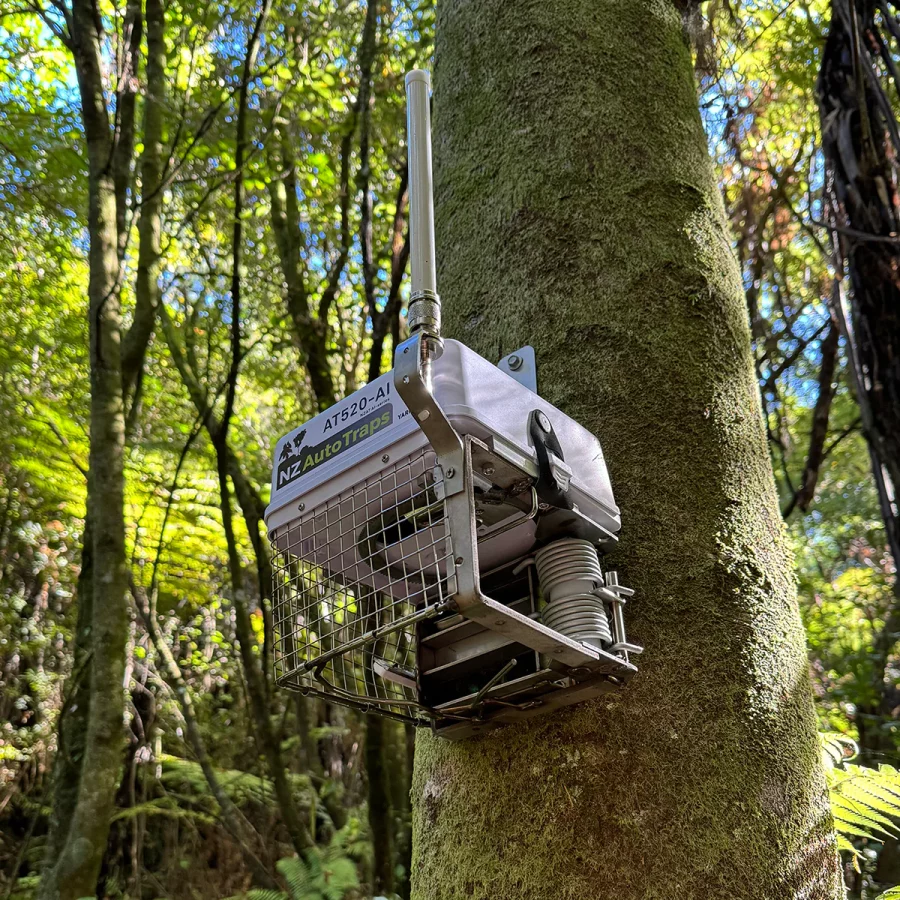A New Zealand-designed pest trap powered by artificial intelligence, solar energy, and long-range wireless networking is being hailed as a breakthrough in pest control technology — one that could render mass poison drops obsolete.
The AT520-AI combines an automatic resetting trap with onboard AI, a camera, and a remote management system. The trap only engages when it visually confirms a target species such as a possum, rat, or stoat. It then sends photo evidence and kill confirmation across a dedicated network of ‘Yarn Mesh’ radio nodes.
The trap is the result of a collaboration between NZ AutoTraps — the firm behind the award-winning AT220 — and FTP Solutions, a global provider of data and communications infrastructure. NZ AutoTraps is 50% owned by New Zealand Carbon Farming and is responsible for the country’s largest private pest control programme.
The system recently received the Dave Galloway Innovation Award from the NZ Biosecurity Institute.
“One of the things we had been looking to improve on for our initial trap design was avoiding the risk of by-kill,” said NZ AutoTraps Operations Manager Haydn Steel. “It’s also important, particularly for groups which are results-funded, to have a reliable record of when the trap has worked.”
FTP Agriculture Manager Jonathan Clark said the AI system uses proximity sensors to detect movement, followed by high-speed image classification.
“As an animal approaches the trap, it detects that movement through the proximity sensors on the AT520, and then the AI camera starts firing off a sequence of images – classifying each image in about one twentieth of a second – and arming the trap only when we get a positive ID on a target species,” Clark said.
The trap then communicates the detection to other nearby traps, which can deploy lures to increase the chance of a successful strike.
“We’ve also added some custom solar panel technology onto the trap and that allows indefinite operation without the need to change a battery or recharge a battery,” Clark added. “So we’re really moving towards automated, landscape-scale operations with as little human energy and input as required.”
The Yarn Mesh system allows the traps to communicate without standard internet infrastructure, even where there is no line of sight. Traps can be placed up to 25km apart.
“So you can actually see which predators are where within the network, where a trap might need to be redeployed to be more successful, where your hot spots are, and where you’ve knocked something right down and can move on to other areas – all backed by detailed data and photographic evidence of each pest kill,” Clark said.
The same system is being explored for use in volunteer safety, with personal locators and two-way text communication possible across the mesh network.
“With the mesh, you’ve got the ability to give your workers a personal locator so you can follow them as they move along the network,” said Steel. “You’ve also got the ability to text message via the network, so if you’ve got no cellular coverage, you can have a two-way text conversation. That means if someone gets in trouble, they can get in touch and help is on its way, or if plans change, you can send them on a different task.”
The next version of the trap, planned for later in 2025, will be able to deploy different lures depending on the species detected, and use built-in audio to attract target animals. An RFID scanner will help prevent the trapping of microchipped domestic cats.
Clark also said the future focus includes tracking signs of biodiversity returning.
“The big conversation we have is about killing pests,” he said. “But we can also create the ability to tell what’s coming back. There’s the potential to add microphones to the system, so we can do bird counts as well.” he added.








